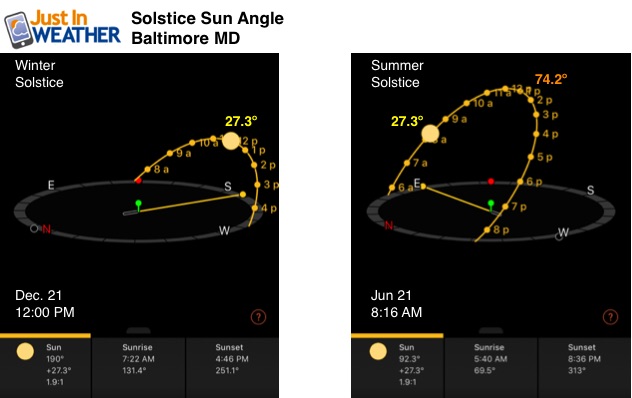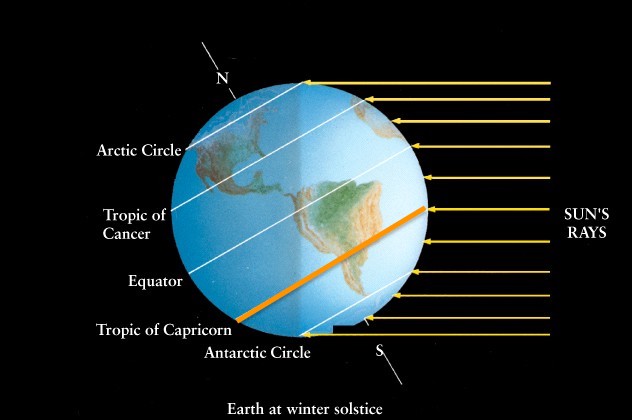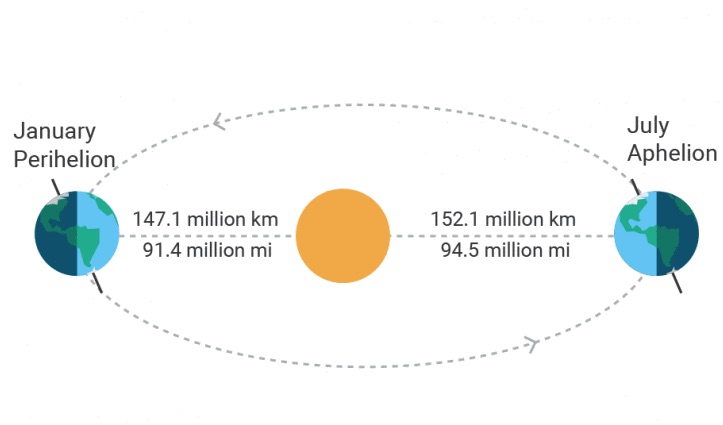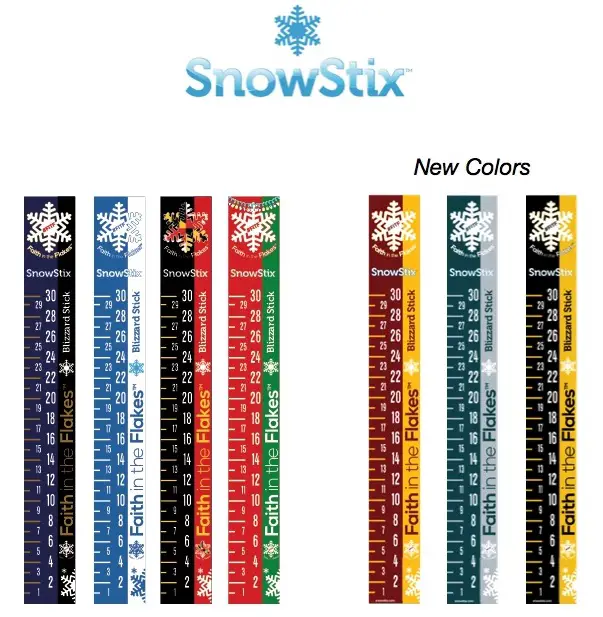December 21 2017
Today is the shortest day of the year. I know someone may say the transition to Daylight Saving Time is shorter when we ‘spring’ forward one hour, but this is about daylight. At 11:28 AM today, Earth will officially be in the winter season. Well, winter for our Northern Hemisphere. Here are eight interesting things you may not have known about the Winter Solstice and the sunlight we receive. This will feed you trivia to make you the life of the holiday party 🙂
1. Lowest Mid Day Sun Angle

Compare this to the longest ‘daylight’ of the year.
Using Baltimore Maryland as our central point, check this out
27.3º is highest sun angle today at Noon
27.3º is the sun angle at 8:16 AM on June 21 (the Summer Solstice)
74.2º is highest sun angle at 1:07 PM on the summer solstice. That means we will have nearly an additional 5 hours of rising sun angle after what we will see at noon today.
2. Shortest Daylight BUT not the sunset
Due to an odd shape to our orbit around the sun, the earliest sunset was a few days ago, and already started getting later.
4:44 PM Sunset Dec 14 to 14
4:47 PM Sunset Dec 21
3. Late Sunrise Gets Later
To compensate for the later sunsets, the sunrise times get later as well… In fact the latest sunrise is more than 1 week away and holds steady for 10 days.
7:23 AM Sunrise Dec 21
7:26 AM Sunrise on Dec 31 through Jan 9
January 10 and through the rest of the season, the morning sunrise will be earlier each day.
4. Days get longer
On the bright side (see what I did there)… The daylight time will be getting longer each day this winter. We will only get a few seconds a day for the next week, but you will notice it more in Janaury.
By January 7 we will gain 1 minute or more of sunlight each day
By January 30th, we will gain 2 minuted or more of sunlight each day
5. Tropic of Capricorn
At 11:38 AM EST, the sun’s ray’s will be focused directly on the Tropic of Capricorn. That is 23.5º South of the equator.

6. Winter here, Summer in the Southern Hemisphere
Yes, in Australia has their Santa often wear shorts. As you can see here. it’d been a marketing campaign for a few decades.

7. Temperature Lag
While the shortest daylight and lowest sun angle is today, it is not the coldest time of the year. There is a temperature lag of about 3 weeks as the low sun angle still allows for Northern Hemisphere cooling.
Average High Temperatures:
44ºF on Dec 21
41ºF on Jan 6 through Jan 24
8. Actually closer to the sun
The elliptical orbit of Earth actually puts our planet closest to the Sun on January 3. That is called perihelion. We are about 3 million miles closer than the opposite in July.

Keep In Touch All Winter
Click here to sign up for email alerts…. Just in case you don’t get the post on your social media feed
Please share your thoughts, best weather pics/video, or just keep in touch via social media
-
Facebook: Justin Berk, Meteorologist
-
Twitter: @JustinWeather
-
Instagram: justinweather
FITF Gear
Snowstix- We Need You To Measure Snow Too
We are giving 10% of each sale to programs that benefit pediatric oncology patients.
 Get the award winning Kid Weather App I made with my oldest son and support our love for science, weather, and technology. Our 3 year anniversary of the release and our contribution to STEM education is this November. It has been downloaded in 60 countries, and works in both temperature scales. With your support we can expand on the fun introduction to science and real weather.
Get the award winning Kid Weather App I made with my oldest son and support our love for science, weather, and technology. Our 3 year anniversary of the release and our contribution to STEM education is this November. It has been downloaded in 60 countries, and works in both temperature scales. With your support we can expand on the fun introduction to science and real weather.
Keep In Touch All Winter
Click here to sign up for email alerts…. Just in case you don’t get the post on your social media feed
Also See:
My Winter Outlook 2017-2018 for more snow
La Nina Formed: What it could mean to our winter
NOAA Winter Outlook: Not The Best But Not The Worst For Snow
Two Farmers Almanacs Winter 2018 Outlooks
Winter Weather Folkore: Suggestions from Animals and Crops
First Frost and Freeze Dates For Maryland (southern PA and northern VA)
My Preliminary Winter Outlook Notes
Low Snow Winters In Baltimore: To Repeat Or Not Repeat
NOAA Ranks Blizzard 2016 4th Worst Snowstorm On Record
Blizzard 2016 Record Top Snowstorm: Area Totals
Extreme Weather of 2015 balanced out on both ends



